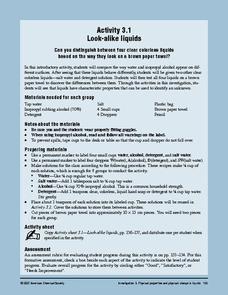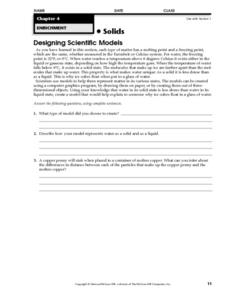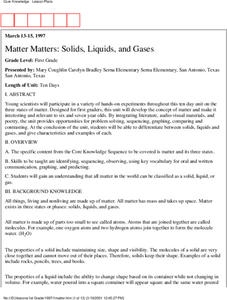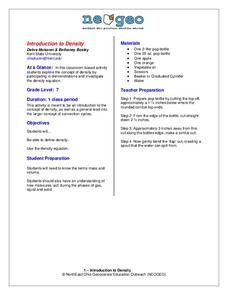American Chemical Society
Investigating the Line
Note that this lesson is best paired with the preceding lesson in the unit. In that lesson, elementary physical scientists observed that the color coating of M&Ms® candies do not mix when dissolved off of the chocolate surface. Now...
Curated OER
Polyhedra Book
In this math worksheet, learners are asked to read the book that focuses upon the creation and explanation of three dimensional shapes.
American Chemical Society
Look-Alike Liquids
Here is the first of four experiments to differentiate among unknown liquids by their behaviors and properties. Pupils observe how different liquids respond to being placed on plastic and paper, and they take notes about their...
Curated OER
Underwater Picture of the Hudson River Estuary
Students identify important aspects of water quality such as slainity and turbidity. They test two of the water quality parameters and determine the quality of the water. In addition, they construct two sets of graphs based on data...
Curated OER
Ooblek
Learners demonstrate the three states of matter. In this matter lesson, students read Bartholomew and the Ooblek. Learners create "ooblek" and discuss what state of matter it is.
Curated OER
Physical and Chemical Changes
Students observe examples of physical changes that can take place between the three states of matter and develop common sense and intuition in distinguishing between chemical and physical changes. They observe diagrams on the board from...
Curated OER
How a Liquid Changes to a Gas
Second graders identify three forms of matter- solids, liquids, and gases with 100% accuracy. They observe water evaporating from an open container and water evaporating and condensing in a closed container. The students assess that a...
Curated OER
States of Matter
In this matter worksheet, students read a chart that uses water to show the three most common states of matter. Students review the properties of solids. This worksheet has 2 graphic organizers and 8 fill in the blank questions.
Curated OER
Science- Unit on Matter- Solids
Second graders identify and describe properties of matter.
They identify three forms of matter- solids, liquids, and gases with 100% accuracy. The student describes the properties of solid objects.
Curated OER
Designing Scientific Models
In this scientific models worksheet, students will use a model to represent matter in its various states. Students can use a computer graphics program, drawing on paper, or three-dimensional creation. Then students will complete 3 short...
Curated OER
Polymers: The Discovery
Students examine various polymers. In this polymers lesson, students perform three experiments with polymers to identify them and observe their interesting properties.
Curated OER
Constancy and Change
Second graders identify three forms of matter- solids, liquids, and gases with 100% accuracy. They observe what happens when they try to put two kinds of matter into the same space and conclude that solids, liquids, and gases occupy space.
Curated OER
Matter Matters: Solids, Liquids and Gases
Scientists participate in a variety of hands-on experiments in this ten-day unit on the three states of matter. Lessons incorporate literature, a-v materials, and poetry to help students differentiate between solids, liquids and gases.
Curated OER
Lipid Worksheet
In this lipid worksheet, high schoolers answer questions about the structure and functions of lipids. They read about the three main lipids in the body including triglycerides, phospholipids and cholesterol and answer questions about each.
Curated OER
Rocks, Minerals, and Erosion
Fourth graders describe the difference between minerals (composed of the same substance throughout) and rocks (composed of two or more minerals). They recognize that there are three classes of rocks: igneous, sedimentary, and metamorphic
Curated OER
States of Matter: Solids, Liquids and Gases
Young scholars explore various states of matter. In this science lesson plan, students recognize the properties of each state of matter and recognize the similarities and differences between the three states of matter.
Curated OER
What's the Matter?
First graders identify solids, liquids, and gases. In this matter activity, the teacher guides students through numerous demonstrations as they determine the properties of solids, liquids, and gases and classify things as each. As the...
Curated OER
Light
Students examine how light waves travel. In this properties of light lesson plan, students observe how light travels in water, how light is reflected and refracted, and how light is pure energy.
Curated OER
Aquatic Science and IPC
Learners explain the importance of water in our daily lives. In this aquatic science lesson plan, students identify different ways to purify water and make it potable. They design and construct a water filter based on researched...
Curated OER
Solids, Liquids, and Gases
First graders explore the properties of matter. In this states of matter lesson, 1st graders conduct scientific investigations that require them to mix, cool, and heat objects in order to observe changes in the properties of matter.
Curated OER
What is a River?
Students study the various types of bodies of water: rivers, oceans, lakes and ponds. They observe models of each and then use clues to discuss how they are alike and different. They imagine they have found a new planet and draw a map...
Curated OER
Florida's Springs
Students calculate the water usage for irrigation of school grounds. They use maps in determining which areas are irrigated.
NorthEast Ohio Geoscience Education Outreach
Introduction to Density
Seventh grade scientists weigh in on the concept of density. In a nutshell, they participate in the following activities:
Measurement of the mass and volume of fruit in order to compare densities
Measurement of the mass of oil and water...
Curated OER
Am I Neutral? pH Properties in Soil
Students participate in a science lab to determine the pH of three different soil samples. Students conduct an experiment by creating a question, a hypothesis and then an investigation of soil samples. Then they compare colors apprearing...

























